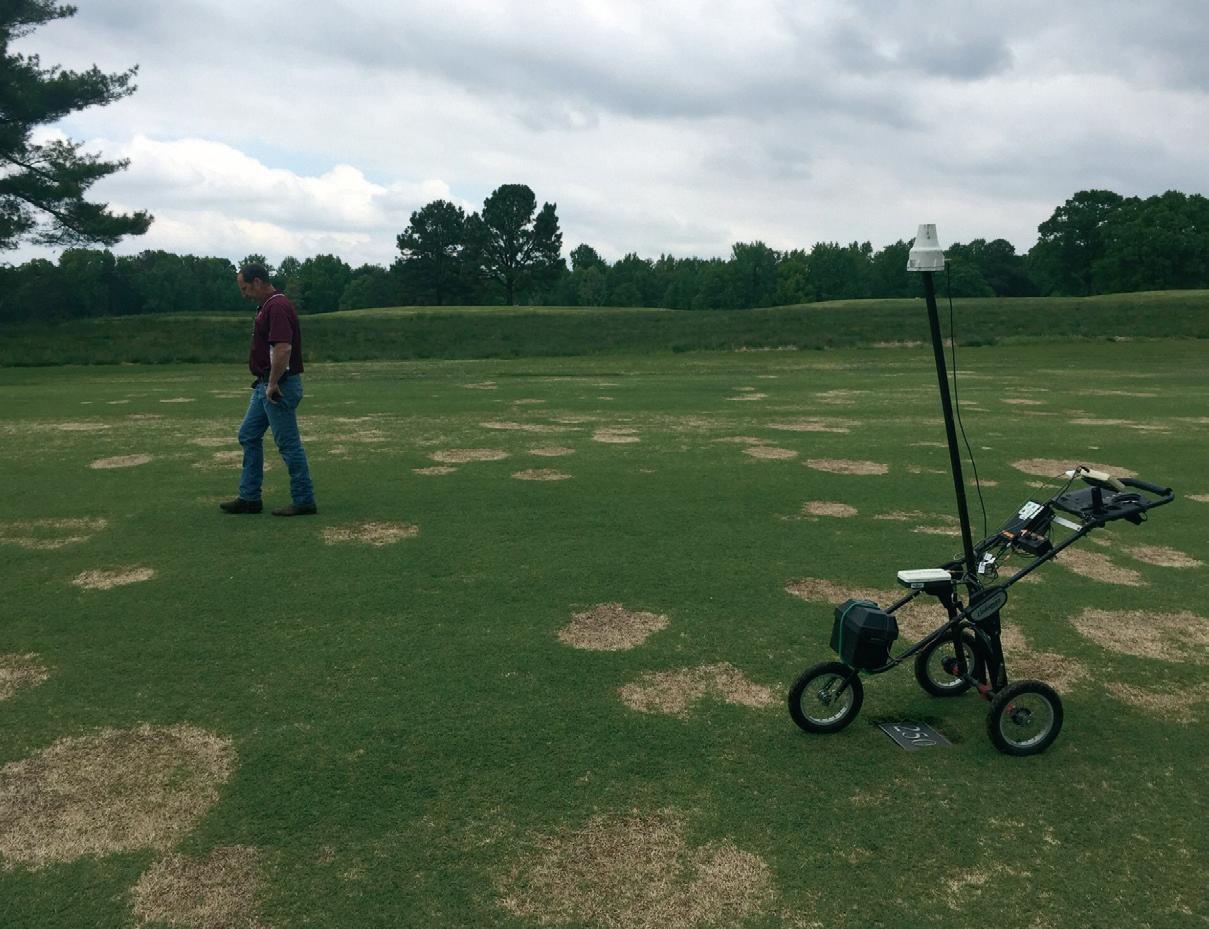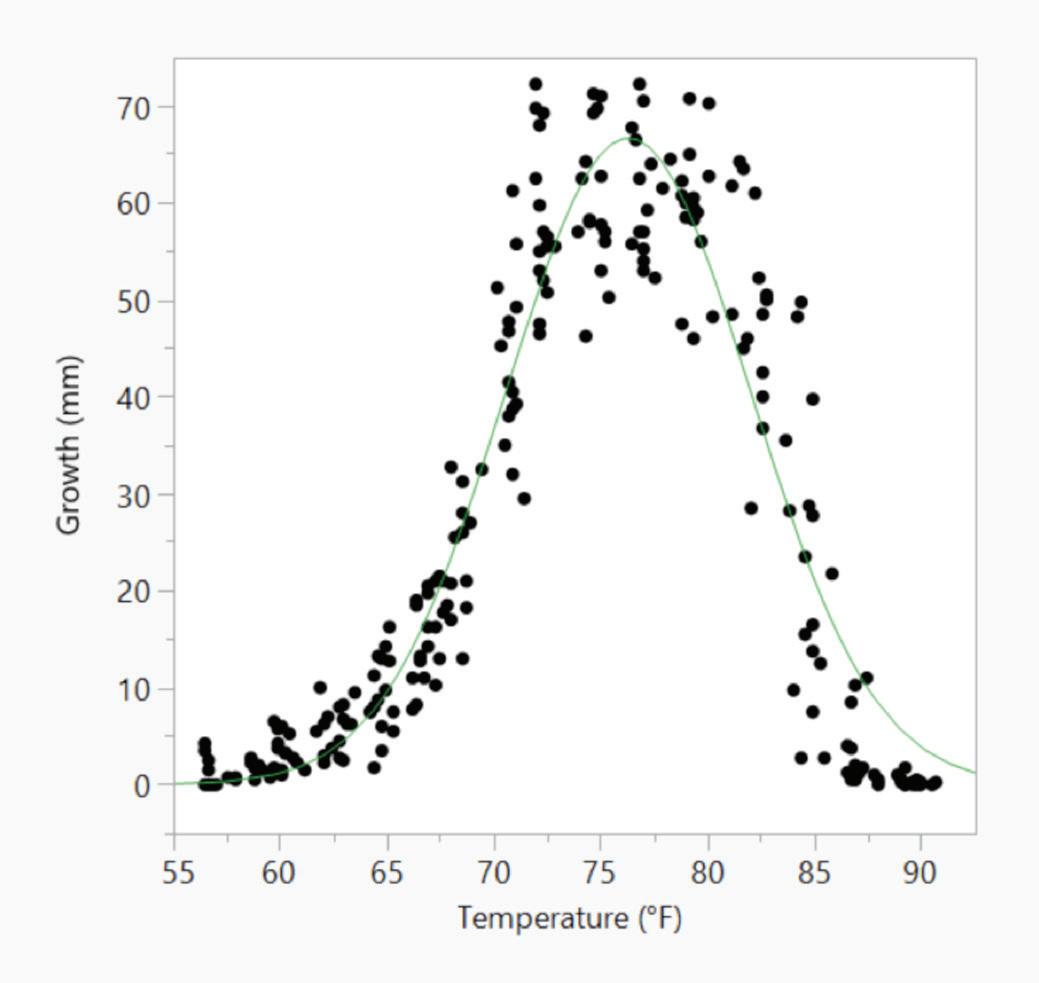
9 minute read
Spring Dead Spot
What Can You do to Manage This Disease?
By Wendell J. Hutchens, Ph.D. student under supervision of David McCall, Ph.D., Virginia Tech
Advertisement
Introduction
The spring of the year is unpredictable for bermudagrass managers in the transition zone. Winterkill and spring dead spot (SDS) can devastate turfgrass stands. Affected bermudagrass exhibits necrotic circular patches at greenup —damage caused by SDS is both aesthetically and economically detrimental, and also provides an uneven playing surface that may increase the likelihood of sports-related injuries (Figure 1).

Figure 1: Outbreak of spring dead spot on a bermudagrass fairway. (Photo by David McCall)
Managing SDS is a year-round task—not just in the fall as previously thought. Preventative fungicide applications employed in the fall are typically the most effective for reducing SDS. However, cultural practices performed throughout the year can impact disease incidence, severity, and recovery. Turfgrass managers should maintain proper soil fertility and pH, apply effective fungicides, and implement other cultural practices to mitigate disease development.
Soil fertility and pH
A fundamental concept of plant pathology is that healthy plants are more likely to withstand pathogen infection, and this holds true with SDS of bermudagrass. Proper soil fertility and pH is vital for turfgrass health. Maintaining proper soil fertility and pH improves the edaphic environment for turfgrass, allowing the plant to outcompete the pathogen. Certain reports suggest that soil pH for bermudagrass should be maintained close to 5-5.3 to mitigate SDS (Dernoeden et al., 1991; Vincelli et al., 1995; Vincelli et al., 1998). Moreover, a pH of 6 has been shown to increase Ophiosphaerella spp. growth in vitro while a pH of 5 or 7 can reduce fungal growth in vitro (Cottrill et al., 2016).
The impact of late-season nitrogen applications has proven inconsistent. One study showed that late-season nitrogen applications increased SDS development (McCarty et al., 1992), yet results have been difficult to duplicate and other studies have suggested otherwise. Late fall applications of potassium sulfate are not recommended as SDS severity can increase the following spring (McCarty et al., 1992). In contrast, monthly applications of ammonium sulfate from May through September can reduce SDS incidence and severity the following spring (Dernoeden et al., 1991). Also, the application of sulfur in conjunction with fungicides over multiple years has the potential to reduce spring dead spot; however, three monthly sulfur applications (87.43 lbs acre -1 ) may cause phytotoxic effects and slowdown spring greenup (Cottrill et al., 2016).
Recent research has also shown that Ophiosphaerella korrae can be suppressed by calcium nitrate applications while Ophiosphaerella herpotrica can be suppressed by ammonium sulfate (Butler, 2017). In contrast, a recent study from the Midwest showed that nitrogen source alone had no effect on SDS control (Cottrill et al., 2016). Although the results have been variable, application of proper fertility and nitrogen source is a potential method for reducing the disease. That being said, the driving factors of SDS epidemics are still not well understood.
SDS fungicide applications
Fungicide applications are the most effective preventative control measure for SDS, particularly with several new chemistries available today. Various researchers throughout the United States have shown that penthiopyrad (Velista), isofetamid (Kabuto), and pyraclostrobin + fluxapyroxad (Lexicon) provide good SDS suppression (Booth et al., 2018; Earlywine and Miller, 2019; Galle et al., 2019; Freund et al., 2019; Roberson et al., 2017). While suppression is less consistent, many turfgrass professionals apply tebuconazole as a more affordable option. The introduction of these products and other novel chemistries provides new hope for increased SDS control.
Proper fungicide application timing is also critical for management of SDS. Historically, applications made in the fall when soil temperatures are between 55 and 70°F have been most effective. However, new research from our lab (Figure 2) has demonstrated that the pathogen is also active at warmer temperatures (68–82°F) when grown in vitro. How this impacts the timing of fungicide applications is still not well understood. Our current hypothesis is that fall applications may need to be made earlier or over a longer period of time (i.e. from September to November) depending on soil temperatures. Split applications made at lower use rates at a 28-day interval with the proper fungicide suppressed SDS more effectively than a single application at higher rates in one study (Roberson et al., 2017). Furthermore, a timely spring application has also been shown to be beneficial in reducing SDS the following year (Walker, 2009).

Figure 2: Effect of temperature on in vitro growth of Ophiosphaerella korrae and Ophiosphaerella herpotrica (R 2 = 0.8987).
Lastly, the fungicide application method used is critical for adequate SDS control. Fenarimol (Rubigan) applications in conjunction with a wetting agent reduce SDS incidence and severity (Beck et al., 2012). Wetting agents and postapplication irrigation increase downward movement of fungicides thereby increasing concentrations of fungicide in the basal portions of the turfgrass plant (Hutchens et al., 2018). Increasing fungicide distribution to the basal portions of the plant where Ophiosphaerella spp. is infecting is likely to increase fungicide efficacy against SDS. It is recommended to apply wetting agents throughout the growing season as well as tank-mix a wetting agent during fungicide applications for SDS. Furthermore, application of at least 1/4" of irrigation when targeting a soilborne pathogen such as Ophiosphaerella spp. is recommended (Hutchens et al., 2018).
Other cultural practices to implement
Aerification, vertical mowing or verticutting, and topdressing reduce thatch and potentially mitigate SDS (Tisserat and Fry, 1997; Vincelli and Williams, 1998; White and Dickens, 1984). Severing stolons creates new growing points and stimulates new growth that can aid in SDS recovery. Fraise mowing, an aggressive approach to remove aboveground material and promote new growth, has successfully reduced SDS severity and increased spring recovery (Miller et al., 2017). It is also recommended to raise mowing heights in the late summer and early fall to prevent stress to the plant going into dormancy––this provides a greater defense for the plant against Ophiosphaerella spp. (Downer et al., 2016).
Planting SDS tolerant cultivars (i.e. cold tolerant cultivars) in newly established areas and in areas that are severely affected with SDS every year is recommended. SDS tolerance of commonly planted bermudagrass cultivars is shown in Table 1 (Vann and Patton, 2019). Also, the newer cultivars ‘Northbridge’ and ‘Latitude 36’ have shown promising results for their cold hardiness, which commonly results in greater SDS tolerance (Kenna, 2016). With this in mind, it is important to note that no cultivar is truly resistant to SDS. Breeders continue to develop new cold-tolerant varieties that will likely improve our ability to successfully manage bermudagrass in Virginia, but this will only be one portion of the SDS equation.
Spring and summer management practices to increase recovery rate
Fall preventative management practices are not always sufficient for adequate SDS control. Therefore, management practices to increase the rate of turfgrass recovery in the spring and summer may be necessary. Aerification in early to mid-summer can help increase warm-season turfgrass recovery and reduce thatch (White and Dickens, 1984). Furthermore, topdressing has been shown to reduce thatch and SDS (Hawes, 1980; White and Dickens, 1984). Early growing season applications of the proper fungicide may also reduce Ophiosphaerella spp. inoculum levels, thereby reducing disease development the following spring. Lastly, applications of fertilizer early in the growing season can speed up warm-season turfgrass recovery.
Table 1: Bermudagrass cultivar tolerances to spring dead spot (Vann and Patton, 2019).
Relative Tolerance • Cultivars
Most • Midfield, Midriron, Midlawn, Patriot, Rivera, Tifsport, Yukon
Moderate • Cheyenne, Mirage, Sundevil II, Tifway 419
Least • Arizona common, Tifton 10, Sahara, Princess 77, Pyramid, Sunbird, Savannah, Transcontinental, Tifgreen
Conclusions and future research
Proper management of SDS is challenging. One management practice alone is not sufficient for managing SDS; however, an integrated, comprehensive management strategy of the aforementioned practices provides the greatest chance for adequate disease control and/or recovery (Vincelli and Williams, 1998).
Our lab is currently focusing on ways to improve management and our understanding of factors that impact disease development. We will be conducting future studies on the edaphic and environmental factors that most influence SDS development. We are also currently testing fungicide sensitivity of the various Ophiosphaerella species. Preliminary research suggests that Ophiosphaerella korrae and Ophiosphaerella herpotrica respond differently to various fungicides, which may help explain why disease control is often inconsistent. Furthermore, we are conducting both statewide and nationwide surveys for the presence of SDS. From these surveys, we will also sample specific locations to determine which species occur in each region.
Citations
Beck, L.L., Moore-Kucera, J., Henry, G., Woodward, J., Zak, J., and Cox, R. 2012. Evaluation of Chemical and Cultural Methods for the Management of Spring Dead Spot in Bermudagrass Turf. Dissertation. Texas Tech University.
Booth, J.C., Askew, S.A., Baudoin, A.B., Goatley, J.M., and McCall, D.S. 2018. Investigating Spring Dead Spot Management via Aerial Mapping and Precision-Guided Inputs. Thesis. Virginia Polytechnic Institute.
Butler, E.L. 2017. Spring Dead Spot in Turf. NC State Extension Publications.
Cottrill, D.J., Earlywine, D.T., and Miller, G.L. 2016. Assessment of Nitrogen Source, Sulfur, and Fall Fungicide Applications on the Management of Spring Dead Spot of Bermudagrass. Plant Disease 100.2: 473-482.
Dernoeden, P. H., J. N. Crahay, and D. B. Davis. 1991. Spring Dead Spot and Bermudagrass Quality As Influenced by Nitrogen Source and Potassium. Crop Sci. 31:1674-1680. doi:10.2135/cropsci1991.0011183X00310 0060058x
Downer, A., Harivandi, M.A., Wong, F., Hartin, J., and Grebus, M.E. Spring Dead Spot. UC IPM Pest Management Guidelines: Turfgrass UC ANR Publication 3365-T.
Earlywine, D. and Miller, G.L. 2019. Evaluation of Kabuto and Velista for preventative spring dead spot control on bermudagrass, 2017-2018. Plant Dis. Manag. Rep. 13:T020. Online publication. doi: 10.1094/PDMR13
Freund, D.R., Kerns, J.P., Butler, E.L., Ploetz, J.N. 2019. Evaluation of fungicides for control of spring dead spot on a bermudagrass putting green, 2017-2018. Plant Dis. Manag. Rep. 13:T005. Online publication. doi: 10.1094/ PDMR13
Galle, G.H., Kerns, J.P., Butler, E.L., and Ploetz, J.N. 2019. Evaluation of Kabuto and Tekken for the control of spring dead spot on Ultradwarf bermudagrass putting greens, 2017–2018. Plant Dis. Manag. Rep. 13:T006. Online publication. doi: 10.1094/PDMR13
Hawes, D. T. 1980. Response of Warm- and Cool-Season Turfgrass Polystands to Nitrogen and Topdressing1. In: J. B. Beard, editor, Proceedings of the Third International Turfgrass Research Conference, ASA, CSSA, SSSA, Madison, WI. p. 65-74. doi:10.2135/1974. proc3rdintlturfgrass.c9
Hutchens, W.J., Gannon, T.W., Shew, H.D., and Kerns, J.P. 2018. Effect of Irrigation Amount and Soil Surfactants on Fungicide Movement and Efficacy in Turfgrass Systems. Thesis. North Carolina State University.
Kenna, Mike. 2016. Cold-Hardy Bermudagrass for Practice Tees. USGA Research Update.
McCarty, L.B., Lucas, L.T., and DiPaola, J.M. 1992. Spring Dead Spot Occurrence in Bermudagrass following Fungicide and Nutrient Applications. HortScience 27.10: 1092-1093. https://doi.org/10.21273/HORTSCI.27.10.1092
Miller, G. L., D. T. Earlywine, and B. S. Fresenburg. 2017. Effect of Fraze Mowing on Spring Dead Spot Caused by Ophiosphaerella herpotricha of Bermudagrass. International Turfgrass Society Research Journal 13:225-228. doi: 10.2134/itsrj2016.10.0839
Roberson, T.L., McCall, D.S., Estes, A., Shelton, C.D. Novel Spring Dead Spot Control Using Isofetamid. Abstract. American Society of Agronomy Meeting, 2017.
Tisserat, N. A., and Fry, J. 1997. Cultural practices to reduce spring dead spot (Ophiosphaerella herpotricha) severity in Cynodon dactylon. Intl. Turfgrass Soc. Res. J. 8:931-936.
Vann, Stephen & Patton, Aaron. 2019. Bermudagrass Spring Dead Spot.
Vincelli, Paul C. and Williams, David, “Managing Spring Dead Spot of Bermudagrass.” 1998. Agriculture and Natural Resources Publications. 62. https://uknowledge.uky.edu/ anr_reports/62
Vincelli, P., Doney, J. C., and Powell, A. J. 1995. Management of spring dead spot of bermudagrass, 1993–1994. Biol. Cult. Tests Control Plant Dis. 10:34.
Walker, N.R. 2009. Influence of Fungicide Application Timings on the Management of Bermudagrass Spring Dead Spot Caused by Ophiosphaerella herpotrica. Plant Disease 93.12: 1341-1345. https://doi.org/10.1094/ PDIS-93-12-1341
White, R. H., and R. Dickens. 1984. Thatch Accumulation in Bermudagrass as Influenced by Cultural Practices1. Agron. J. 76:19-22. doi:10.2134/agronj1984.0002196200 7600010006x









